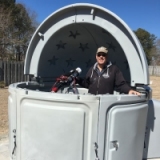INDI Library v2.0.7 is Released (01 Apr 2024)
Bi-monthly release with minor bug fixes and improvements
New Focus Algorithm in Ekos
- Bernd Limburg
-

- Offline
- Premium Member
-

- Posts: 145
- Thank you received: 15
Replied by Bernd Limburg on topic New Focus Algorithm in Ekos
Regards, Bernd
Please Log in or Create an account to join the conversation.
- Ron Clanton
-

- Offline
- Elite Member
-

- Posts: 225
- Thank you received: 16
Replied by Ron Clanton on topic New Focus Algorithm in Ekos
John,
Thank you. I understand the process... but in my case, when it does the "backlash hokey-cokey" it moves out then in so quickly, that I don't think the focuser has reached the full "out" setting. I think it would benefit from a move out, pause 1 second, move in... to assure that it getting the full effect.
Thanks,
Ron
Please Log in or Create an account to join the conversation.
Replied by Doug S on topic New Focus Algorithm in Ekos
A couple thoughts for you. I like the approach, it has a BIG advantage over the current linear alg in that it doesn't "pull up short" which has previously been described by prior posts on the subject.
My only suggestion is to consider whether you want to make the same mistake Linear Alg made in the Mechanics tab. Picking an "Initial Step", and "Out Step Multiple" has created a lot of unnecessary confusion for folks. In reality, the "proper" way to define the step size and out step multiple is to calculate those parameters from other system info as it relates to CFZ. Knowing the focus drawtube screw pitch and motor scale would ensure the correct step-size is used. Alternatively, not knowing these parameters creates the conditions for step-size exceeding the CFZ (jumps over), or too small (wasting focus time). This is completely avoidable. You might want to consider at least having an option to calculate the step size, correlating to CFZ, motor scale, and focuser thread pitch size. See the following info which might help:
www.goldastro.com/goldfocus/ncfz.php
Cheers, and good luck, Doug S
Please Log in or Create an account to join the conversation.
- Ron Clanton
-

- Offline
- Elite Member
-

- Posts: 225
- Thank you received: 16
Replied by Ron Clanton on topic New Focus Algorithm in Ekos
Thanks for the thoughts. I have read this article and find it interesting. I guess that I have used "trial and error" for my different scopes and focusers.
Like others, I find that the "one pass" does a pretty good job at finding the best focus. The second pass process, while theoretically valuable, does little to improve the focus. In fact, it usually was the cause of creating an error, aborting and restarting the process.
I'm looking forward to using John's new process!
Ron
Please Log in or Create an account to join the conversation.
Replied by John on topic New Focus Algorithm in Ekos
Please Log in or Create an account to join the conversation.
Replied by John on topic New Focus Algorithm in Ekos
Please Log in or Create an account to join the conversation.
- Ron Clanton
-

- Offline
- Elite Member
-

- Posts: 225
- Thank you received: 16
Replied by Ron Clanton on topic New Focus Algorithm in Ekos
I only use the Celestron focuser with the linear method of my Celestron 8HD Edge. I'm not sure that I would describe it as an issue with the mechanics... the current process just doesn't give the focuser time to complete the "out" movement before it issues an "in" command. It may be working fine and I'm simply experiencing what Doug is describing. However, when I'm sitting at the scope it sounds like it starts reversing before it finishes the out movement.
This is one of those situations where I would think it wouldn't hurt to have a very short (1 sec) pause between commands.
BTW... I'm not fond of the Celestron focuser. I sometimes experience connection issues with INDI... seems unstable. I've ordered an ZWO EAF to replace it on the 8HD Edge, but have been waiting several weeks for the back order to clear.
The ZWO EAF on my refractor works perfectly with the polynomial process.
Thanks for your effort!
Ron
Please Log in or Create an account to join the conversation.
Replied by Jim on topic New Focus Algorithm in Ekos
Please Log in or Create an account to join the conversation.
Replied by John on topic New Focus Algorithm in Ekos
Please Log in or Create an account to join the conversation.
Replied by Doug S on topic New Focus Algorithm in Ekos
It would be best if the algorithm calculated step size from user input of how many microns per revolution the focus motor has, and how many microns of focuser drawtube travel occurs per revolution of the focusing mechanism. Not knowing these two values, and just "winging" a generic step size is just guessing. Folks should try to get some understanding of their CFZ and then set a step size to match the instrument. Since some will not want or know this info (or won't want to go to the trouble to find it), the guess may need to be allowed. But a better solution would be to allow for a precise calculation when the parameters are known.
Please Log in or Create an account to join the conversation.
- Peter Kennett
-

- Offline
- Platinum Member
-

- Posts: 999
- Thank you received: 155
Replied by Peter Kennett on topic New Focus Algorithm in Ekos
What I found worked was to let EKOS run through the first pass, and then I would move the focuser outward a ways (to take up the backlash) and then move it inward to the calculated spot. It worked great - but was basically manual.
With the C11 EdgeHD and ZWO EAF it was important that the final focus movement was INWARD. Otherwise I would end up with some mirror tilt.
Please Log in or Create an account to join the conversation.
- Bernd Limburg
-

- Offline
- Premium Member
-

- Posts: 145
- Thank you received: 15
Replied by Bernd Limburg on topic New Focus Algorithm in Ekos
The linear 1-pass algo (in principle any focus algo) then could have 3 additional (optional) input fields: "Microns per motor step", "Critical focus zone in micron" and "Desired step size in CFZ units". The latter can default to 0.5, but the user can overwrite it (using 1, for instance, or whatever).
The calculated step size would then be "Desired step size in CFZ units" x "CFZ in micron" / "Microns per motor step". Alternatively, the user can ignore those additional input fields and enter the step size manually as it is today.
Please Log in or Create an account to join the conversation.
